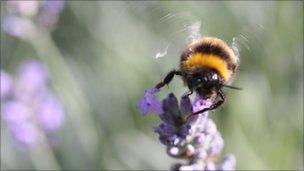Dounreay dump site could be made suitable for birds
- Published

A new sea defence has been planned for Landfill 42
A former dump at a nuclear plant could eventually provide habitat for birds under plans to close and cover it over.
Dounreay Site Restoration Limited (DSRL) has proposed filling in Landfill 42, external at Dounreay in Caithness at a cost of between £1m to £2m.
The work would involve 25,000 tonnes of rock and a top layer of gravel suitable for nesting seabirds.
The Atomic UK Atomic Energy Authority was fined in 2006 after radioactive material was found at the dump.
DSRL said the small amounts of radioactivity dated from construction work done at Dounreay in the 1960s and 1970s.
It said the dump contained other hazardous materials, including asbestos.
Phil Cartwright, contaminated land manager at DSRL, said extensive work had been carried out in recent years on the plans to restore the land.
He said: "We studied several options for closure of the landfill and carefully considered the environmental impact of each.

A field at Dounreay has been earmarked for a meadow to help bumblebees
"We believe the facility can be left in a safe condition with the engineering measures identified in our closure application to the Scottish Environment Protection Agency."
A new sea defence would have to constructed to protect the coastal landfill site from erosion.
Landfill 42 has not been used since 2006.
In July last year, it was announced that a field at the defunct nuclear power plant would be turned into a wild flower meadow to help boost bumblebee numbers.
The site in front of Dounreay's Prototype Fast Reactor has been deemed clean of radioactivity and already has orchids and clover growing.
One of the target species the project aims to help is the great yellow - among Britain's rarest bumblebees.
The Bumblebee Conservation Trust has given advice on the meadow plan.
- Published29 July 2010